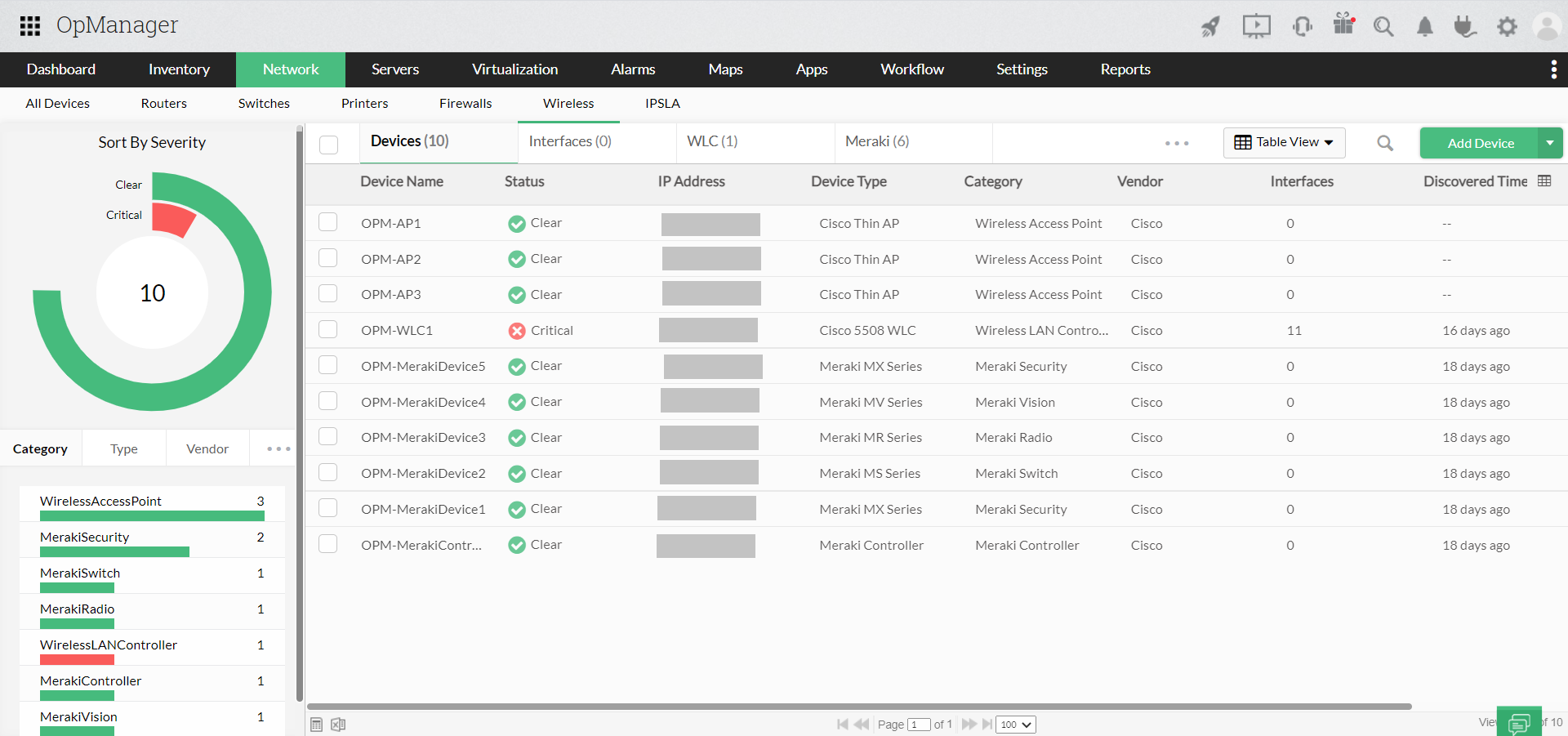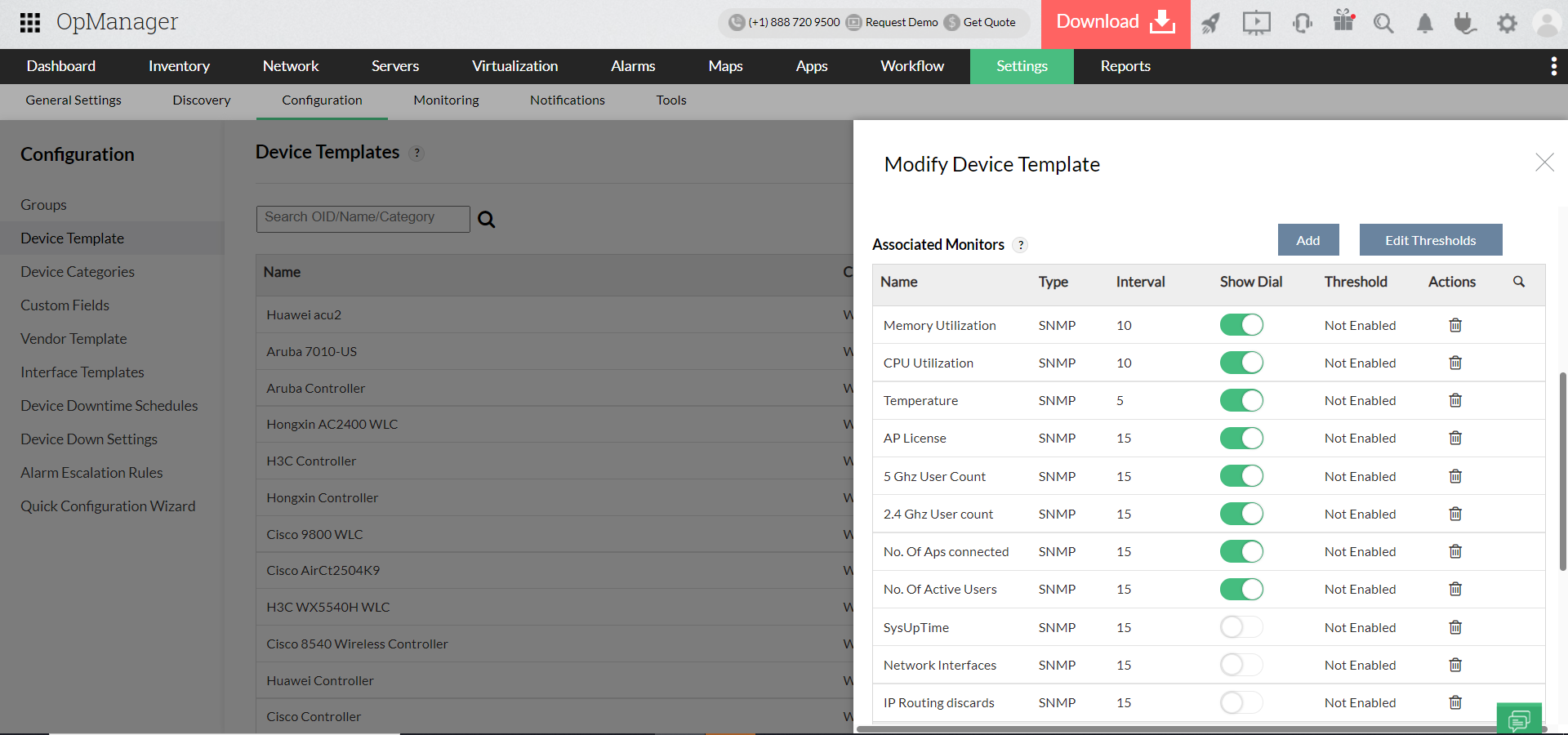Wi-Fi networks have become an integral part of an organization's need to scale across wired, wireless, and virtual environments to meet IT requirements. Thanks to its cost-effectiveness, scalability, and simplicity, Wi-Fi networks are now widely used to boost the remote connectivity, availability, and accessibility of IT infrastructures.
However, WiFi monitoring is crucial to ensure the efficiency and continuity of these networks. Several factors, such as the amount of traffic handled by your Wi-Fi network, can easily deteriorate the user experience without an Wi-Fi monitor in place. Using an effective WiFi monitoring software helps you stay in control of your WiFi environment and its components. Deploying a reliable Wi-Fi monitoring solution helps monitor, and analyze the Wi-Fi network's performance metrics and network components with ease. In this page we will be looking into:
OpManager's WiFi analyzer software offers you in depth visibility into your Wi-Fi networks with its comprehensive set of WiFi monitors. As a part of the network discovery process, it discovers and identifies wireless networking components, such as the Wireless LAN Controllers and access points. Once discovered, OpManager classifies these devices based on aspects such as the device type, and automatically monitors them.
Offering a range of capabilities that enable network surveillance and availability monitoring, OpManager's Wi-Fi monitor helps you ensure that your Wi-Fi networks are continually available and accessible. With several built in monitors and device templates, this Wi-Fi monitoring solution enables you to track key performance metrics of your Wi-Fi networks and monitor the health of your Wi-Fi network components.

High throughput, low latency, and low variability are some of the ideal characteristics of an Wi-Fi networking environment. However, factors such as the type of Wi-Fi component used, location of the end user, and the number of end users can become challenging to your Wi-Fi network's performance.
To tackle these challenges, OpManager's enterprise Wi-Fi monitoring offers you a wide range of monitors that act as your Wi-Fi network's performance indicators. Loaded with a range of device templates, this Wi-Fi monitoring system classifies discovered Wi-Fi components and associates predefined set of monitors to your Wi-Fi components. You can also associate other monitors as per your requirement. With it comprehensive Wi-Fi monitoring capabilities, OpManager WiFi monitor software helps you track key metrics, such as:
The quality of your network's Wi-Fi signals is an important aspect that determines your end user's networking experience. As we've seen, interferences within your Wi-Fi environment can deteriorate the signal strength by increasing the SNR. The WiFi monitor you've deployed in your network should have sufficient capabilities to keep tabs on the SNR ratio your network experiences. OpManger's Wi-Fi network monitoring helps you monitor the signal strength by associating the various signal strength monitors that are available to your Wi-Fi components. The monitors that are available with this WiFi monitor tool can help you monitor the SNR, received and transmitted bytes, and more, enabling overall signal strength analysis.

Having comprehensive insights into how the Wi-Fi networks are being used helps network administrators enable continuous network availability, without running into network issues. To enable this, network admins rely on Wi-Fi monitoring solutions that offer Wi-Fi monitors to track the above said metrics. With several monitors to track factors like packet loss, CPU utilization, memory utilization, and the total bytes transmitted by the client, OpManager's Wi-Fi performance monitoring enables you to effectively analyze their network utilization. This Wi-Fi performance monitor allows you to set multiple threshold-based alerts that can warn you in case there are issues such as resource overutilization in your Wi-Fi networks.

The traffic in your Wi-Fi network has a direct impact on the bandwidth accessible to your end users. Increased traffic from competing end users can constantly change the bandwidth allocated to other users. Unmonitored traffic can lead to connection disruptions causing network downtime. Using an effective WiFi network monitor helps you simplify this task.
OpManager's Wireless monitor enables you to continuously track Wi-Fi traffic with a range of monitors, including the Wi-Fi network traffic monitor. These monitors help you set up thresholds on the ideal traffic limit, based on the Wi-Fi components you used and the network environment. If the traffic limit crosses or falls below the thresholds set, Wi-Fi monitor instantly alerts you via various channels, including email, and SMS.

For any network environment to function undisrupted, it is crucial that the network components are available uninterrupted. This is particularly important in Wi-Fi networks, since an access point that is down can cause a connectivity blackout to hundreds of end users in your Wi-Fi network. Continuous Wi-Fi network monitoring aids you in this process.
OpManager's Wi-Fi monitoring uses various network protocols, such as ICMP, TCP and SNMP, to continually poll your Wi-Fi components. This Wi-Fi monitor automates network polling by enabling you to set up the required polling intervals. Once set, OpManager's Wi-Fi monitoring tool automatically triggers the polls at the set intervals. Polling determines the availability of your Wi-Fi components and helps analyze the downtime statistics and historical logs.

One of the important metrics to monitor in your Wi-Fi networks, is the number of end users. This metric directly determines the load on your Wi-Fi components, such as the end user's access point. An overload may result in network issues, such as loss of connectivity and insufficient bandwidth. Using a Wi-Fi monitor offers you a clear view into these metrics.
WiFi monitoring helps you track this metric by displaying the number clients, the service set identifier (SSID) they belong to, and the access point they are connected. With the Wi-Fi monitor's capabilities like Active Clients Count monitoring, you can also track the number of end users currently online in your network.

OpManager's Wi-Fi monitoring solution gives you an holistic view of your Wi-Fi networks, as it monitors key performance metrics. This comprehensive WiFi monitor helps you monitor various aspects of your Wi-Fi components such as the uptime, temperature, CPU utilization, and memory utilization. These WiFi monitoring metrics help you boost the performance and availability of your Wi-Fi networks. OpManager's comprehensive enterprise WiFi monitoring capabilities include:
Proactive network monitoring: The Wi-Fi monitor offers diverse network monitors which help you proactively monitor your network environment and detect network issues before they occur.
Automated network tasks: OpManager automates monotonous network tasks, such as availability polling, assigning monitors, and device rediscovery, with capabilities such as scheduling, workflow, and discovery rule engine.
Effective network troubleshooting: In case of a network issue, instant threshold-based alerts enable you to promptly take action on any issues that might disrupt the normal functioning of your IT environment.
Analyzing network performance: A diverse set of built-in granular reports enables you to analyze various metrics, such as uptime, and resource utilization, to enhance your capacity planning, and audit network operations.
OpManager provides you with more than just Wi-Fi monitoring. It is a complete network monitoring solution that enables you to keep track of all your network devices, such as servers, routers, virtual machines, storage devices, and more. Start monitoring your IT infrastructure along with your Wi-Fi networks with OpManager today.
Want to know more? Schedule a personalized free demo with our product experts who can answer your questions. Get started for free by downloading a 30-day trial and experience hand-on how OpManger can help you boost your network performance.
 Recognized as a May 2019 Gartner Peer Insights Customers' Choice for Network Performance Monitoring and Diagnostics Software
Recognized as a May 2019 Gartner Peer Insights Customers' Choice for Network Performance Monitoring and Diagnostics Software  Recognised as an April 2019 Gartner Peer Insights Customers' Choice for IT Infrastructure Monitoring Tools.
Recognised as an April 2019 Gartner Peer Insights Customers' Choice for IT Infrastructure Monitoring Tools.  Network Management and Monitor Vendor of the Year 2018, 2019
Network Management and Monitor Vendor of the Year 2018, 2019  Entered the 2019 Gartner NPMD Magic Quadrant.
Entered the 2019 Gartner NPMD Magic Quadrant.  Ranked #2 in the Infotech Research Software Reviews Data Quadrant 2018.
Ranked #2 in the Infotech Research Software Reviews Data Quadrant 2018.